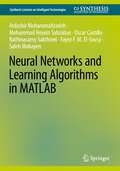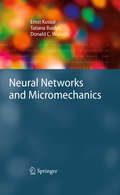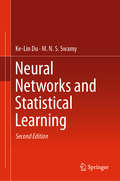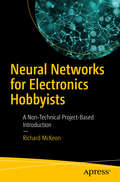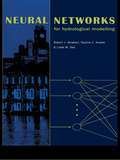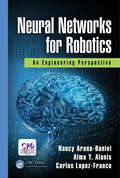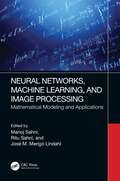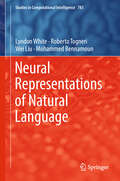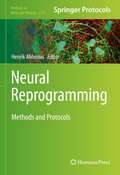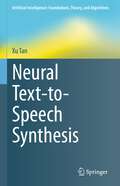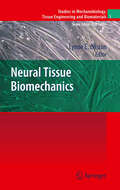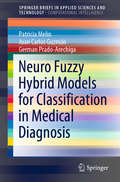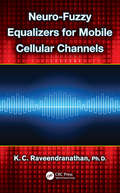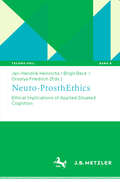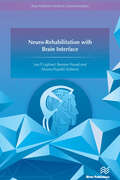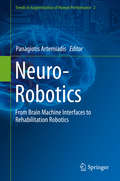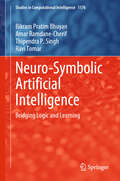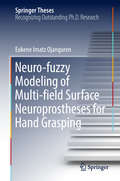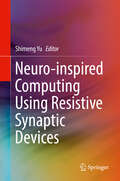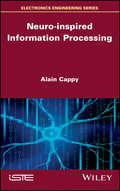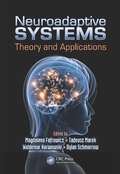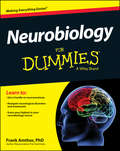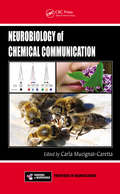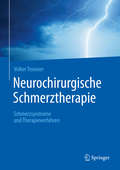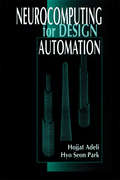- Table View
- List View
Neural Networks and Learning Algorithms in MATLAB (Synthesis Lectures on Intelligent Technologies)
by Oscar Castillo Rathinasamy Sakthivel Mohammad Hosein Sabzalian Fayez F. El-Sousy Ardahir Mohammadazadeh Saleh MobayenThis book explains the basic concepts, theory and applications of neural networks in a simple unified approach with clear examples and simulations in the MATLAB programming language. The scripts herein are coded for general purposes to be easily extended to a variety of problems in different areas of application. They are vectorized and optimized to run faster and be applicable to high-dimensional engineering problems. This book will serve as a main reference for graduate and undergraduate courses in neural networks and applications. This book will also serve as a main basis for researchers dealing with complex problems that require neural networks for finding good solutions in areas, such as time series prediction, intelligent control and identification. In addition, the problem of designing neural network by using metaheuristics, such as the genetic algorithms and particle swarm optimization, with one objective and with multiple objectives, is presented.
Neural Networks and Micromechanics
by Tatiana Baidyk Ernst Kussul Donald C. WunschThis is an interdisciplinary field of research involving the use of neural network techniques for image recognition applied to tasks in the area of micromechanics. The book is organized into chapters on classic neural networks and novel neural classifiers; recognition of textures and object forms; micromechanics; and adaptive algorithms with neural and image recognition applications. The authors include theoretical analysis of the proposed approach, they describe their machine tool prototypes in detail, and they present results from experiments involving microassembly, and handwriting and face recognition. This book will benefit scientists, researchers and students working in artificial intelligence, particularly in the fields of image recognition and neural networks, and practitioners in the area of microengineering.
Neural Networks and Statistical Learning
by Ke-Lin Du M. N. SwamyThis book provides a broad yet detailed introduction to neural networks and machine learning in a statistical framework. A single, comprehensive resource for study and further research, it explores the major popular neural network models and statistical learning approaches with examples and exercises and allows readers to gain a practical working understanding of the content. This updated new edition presents recently published results and includes six new chapters that correspond to the recent advances in computational learning theory, sparse coding, deep learning, big data and cloud computing.Each chapter features state-of-the-art descriptions and significant research findings. The topics covered include:• multilayer perceptron;• the Hopfield network;• associative memory models;• clustering models and algorithms;• t he radial basis function network;• recurrent neural networks;• nonnegative matrix factorization;• independent component analysis;•probabilistic and Bayesian networks; and• fuzzy sets and logic.Focusing on the prominent accomplishments and their practical aspects, this book provides academic and technical staff, as well as graduate students and researchers with a solid foundation and comprehensive reference on the fields of neural networks, pattern recognition, signal processing, and machine learning.
Neural Networks for Electronics Hobbyists: A Non-technical Project-based Introduction
by Richard McKeonLearn how to implement and build a neural network with this non-technical, project-based book as your guide. As you work through the chapters, you'll build an electronics project, providing a hands-on experience in training a network. There are no prerequisites here and you won't see a single line of computer code in this book. Instead, it takes a hardware approach using very simple electronic components. You'll start off with an interesting non-technical introduction to neural networks, and then construct an electronics project. The project isn't complicated, but it illustrates how back propagation can be used to adjust connection strengths or "weights" and train a network. By the end of this book, you'll be able to take what you've learned and apply it to your own projects. If you like to tinker around with components and build circuits on a breadboard, Neural Networks for Electronics Hobbyists is the book for you. What You'll LearnGain a practical introduction to neural networksReview techniques for training networks with electrical hardware and supervised learningUnderstand how parallel processing differs from standard sequential programmingWho This Book Is ForAnyone interest in neural networks, from electronic hobbyists looking for an interesting project to build, to a layperson with no experience. Programmers familiar with neural networks but have only implemented them using computer code will also benefit from this book.
Neural Networks for Hydrological Modeling
by Linda M. See Pauline E. Kneale Robert J. AbrahartA new approach to the fast-developing world of neural hydrological modelling, this book is essential reading for academics and researchers in the fields of water sciences, civil engineering, hydrology and physical geography. Each chapter has been written by one or more eminent experts working in various fields of hydrological modelling. The b
Neural Networks for Robotics: An Engineering Perspective
by Alma Y. Alanis Nancy Arana-Daniel Carlos Lopez-FrancoThe book offers an insight on artificial neural networks for giving a robot a high level of autonomous tasks, such as navigation, cost mapping, object recognition, intelligent control of ground and aerial robots, and clustering, with real-time implementations. The reader will learn various methodologies that can be used to solve each stage on autonomous navigation for robots, from object recognition, clustering of obstacles, cost mapping of environments, path planning, and vision to low level control. These methodologies include real-life scenarios to implement a wide range of artificial neural network architectures. Includes real-time examples for various robotic platforms. Discusses real-time implementation for land and aerial robots. Presents solutions for problems encountered in autonomous navigation. Explores the mathematical preliminaries needed to understand the proposed methodologies. Integrates computing, communications, control, sensing, planning, and other techniques by means of artificial neural networks for robotics.
Neural Networks, Machine Learning, and Image Processing: Mathematical Modeling and Applications
by Manoj Sahni Ritu Sahni Jose M. MerigoSECTION I Mathematical Modeling and Neural Network’ Mathematical Essence Chapter 1 Mathematical Modeling on Thermoregulation in Sarcopenia1.1. Introduction 1.2. Discretization 1.3. Modeling and Simulation of Basal Metabolic Rate and Skin Layers Thickness 1.4. Mathematical Model and Boundary Conditions 1.5. Solution of the Model 1.6. Numerical Results and discussion 1.7. Conclusion References Chapter 2 Multi-objective University Course Scheduling for Un
Neural Representations of Natural Language (Studies in Computational Intelligence #783)
by Wei Liu Roberto Togneri Lyndon White Mohammed BennamounThis book offers an introduction to modern natural language processing using machine learning, focusing on how neural networks create a machine interpretable representation of the meaning of natural language. Language is crucially linked to ideas – as Webster’s 1923 “English Composition and Literature” puts it: “A sentence is a group of words expressing a complete thought”. Thus the representation of sentences and the words that make them up is vital in advancing artificial intelligence and other “smart” systems currently being developed. Providing an overview of the research in the area, from Bengio et al.’s seminal work on a “Neural Probabilistic Language Model” in 2003, to the latest techniques, this book enables readers to gain an understanding of how the techniques are related and what is best for their purposes. As well as a introduction to neural networks in general and recurrent neural networks in particular, this book details the methods used for representing words, senses of words, and larger structures such as sentences or documents. The book highlights practical implementations and discusses many aspects that are often overlooked or misunderstood. The book includes thorough instruction on challenging areas such as hierarchical softmax and negative sampling, to ensure the reader fully and easily understands the details of how the algorithms function. Combining practical aspects with a more traditional review of the literature, it is directly applicable to a broad readership. It is an invaluable introduction for early graduate students working in natural language processing; a trustworthy guide for industry developers wishing to make use of recent innovations; and a sturdy bridge for researchers already familiar with linguistics or machine learning wishing to understand the other.
Neural Reprogramming: Methods and Protocols (Methods in Molecular Biology #2352)
by Henrik AhleniusThis detailed book brings together a number of state-of-the-art protocols to generate different types of neural cells through the use of reprogramming technologies. Additionally, the volume explores different aspects of functional evaluation and applications of reprogrammed neural cells as well as in silico methods to aid reprogramming efforts. Written for the highly successful Methods in Molecular Biology series, chapters include introductions to their respective topics, lists of the necessary materials and reagents, step-by-step, readily reproducible laboratory protocols, and tips on troubleshooting and avoiding known pitfalls. Authoritative and cutting-edge, Neural Reprogramming: Methods and Protocols provides ample experimental experience and guidance for anyone, be it experienced researcher or beginner, to generate, validate, and apply reprogrammed neural cells in their research.
Neural Text-to-Speech Synthesis (Artificial Intelligence: Foundations, Theory, and Algorithms)
by Xu TanText-to-speech (TTS) aims to synthesize intelligible and natural speech based on the given text. It is a hot topic in language, speech, and machine learning research and has broad applications in industry. This book introduces neural network-based TTS in the era of deep learning, aiming to provide a good understanding of neural TTS, current research and applications, and the future research trend. This book first introduces the history of TTS technologies and overviews neural TTS, and provides preliminary knowledge on language and speech processing, neural networks and deep learning, and deep generative models. It then introduces neural TTS from the perspective of key components (text analyses, acoustic models, vocoders, and end-to-end models) and advanced topics (expressive and controllable, robust, model-efficient, and data-efficient TTS). It also points some future research directions and collects some resources related to TTS. This book is the first to introduce neural TTS in a comprehensive and easy-to-understand way and can serve both academic researchers and industry practitioners working on TTS.
Neural Tissue Biomechanics
by Lynne E. BilstonDamage to the central nervous system resulting from pathological mechanical loading can occur as a result of trauma or disease. Such injuries lead to significant disability and mortality. The peripheral nervous system, while also subject to injury from trauma and disease, also transduces physiological loading to give rise to sensation, and mechanotransduction is also thought to play a role in neural development and growth. This book gives a complete and quantitative description of the fundamental mechanical properties of neural tissues, and their responses to both physiological and pathological loading. This book reviews the methods used to characterize the nonlinear viscoelastic properties of central and peripheral neural tissues, and the mathematical and sophisticated computational models used to describe this behaviour. Mechanisms and models of neural injury from both trauma and disease are reviewed from the molecular to macroscopic scale. The book provides a comprehensive picture of the mechanical and biological response of neural tissues to the full spectrum of mechanical loading to which they are exposed. This book provides a comprehensive reference for professionals involved in pre prevention of injury to the nervous system, whether this arises from trauma or disease.
Neuro Fuzzy Hybrid Models for Classification in Medical Diagnosis (SpringerBriefs in Applied Sciences and Technology)
by Patricia Melin German Prado-Arechiga Juan Carlos GuzmánThis book is focused on the use of intelligent techniques, such as fuzzy logic, neural networks and bio-inspired algorithms, and their application in medical diagnosis. The main idea is that the proposed method may be able to adapt to medical diagnosis problems in different possible areas of the medicine and help to have an improvement in diagnosis accuracy considering a clinical monitoring of 24 hours or more of the patient.In this book, tests were made with different architectures proposed in the different modules of the proposed model. First, it was possible to obtain the architecture of the fuzzy classifiers for the level of blood pressure and for the pressure load, and these were optimized with the different bio-inspired algorithms (Genetic Algorithm and Chicken Swarm Optimization). Secondly, we tested with a local database of 300 patients and good results were obtained. It is worth mentioning that this book is an important part of the proposed general model; for this reason, we consider that these modules have a good performance in a particular way, but it is advisable to perform more tests once the general model is completed.
Neuro-Fuzzy Equalizers for Mobile Cellular Channels
by K.C. RaveendranathanEqualizers are present in all forms of communication systems. Neuro-Fuzzy Equalizers for Mobile Cellular Channels details the modeling of a mobile broadband communication channel and designing of a neuro-fuzzy adaptive equalizer for it. This book focuses on the concept of the simulation of wireless channel equalizers using the adaptive-network-based fuzzy inference system (ANFIS). The book highlights a study of currently existing equalizers for wireless channels. It discusses several techniques for channel equalization, including the type-2 fuzzy adaptive filter (type-2 FAF), compensatory neuro-fuzzy filter (CNFF), and radial basis function (RBF) neural network. Neuro-Fuzzy Equalizers for Mobile Cellular Channels starts with a brief introduction to channel equalizers, and the nature of mobile cellular channels with regard to the frequency reuse and the resulting CCI. It considers the many channel models available for mobile cellular channels, establishes the mobile indoor channel as a Rayleigh fading channel, presents the channel equalization problem, and focuses on various equalizers for mobile cellular channels. The book discusses conventional equalizers like LE and DFE using a simple LMS algorithm and transversal equalizers. It also covers channel equalization with neural networks and fuzzy logic, and classifies various equalizers. This being a fairly new branch of study, the book considers in detail the concept of fuzzy logic controllers in noise cancellation problems and provides the fundamental concepts of neuro-fuzzy. The final chapter offers a recap and explores venues for further research. This book also establishes a common mathematical framework of the equalizers using the RBF model and develops a mathematical model for ultra-wide band (UWB) channels using the channel co-variance matrix (CCM). Introduces the novel concept of the application of adaptive-network-based fuzzy inference system (ANFIS) in the design of wireless channel equalizers Provides model ultra-wide band (UWB) channels using channel co-variance matrix Offers a formulation of a unified radial basis function (RBF) framework for ANFIS-based and fuzzy adaptive filter (FAF) Type II, as well as compensatory neuro-fuzzy equalizers Includes extensive use of MATLAB® as the simulation tool in all the above cases
Neuro-ProsthEthics: Ethical Implications of Applied Situated Cognition (Techno:Phil – Aktuelle Herausforderungen der Technikphilosophie #9)
by Jan-Hendrik Heinrichs Birgit Beck Orsolya FriedrichThe volume focusses on the ethical dimensions of the technological scaffold embedding human thought and action, which has been brought to attention of the cognitive sciences by situated cognition theories. There is a broad spectrum of technologies co-realising or enabling and enhancing human cognition and action, which vary in the degree of bodily integration, interactivity, adaptation processes, of reliance and indispensability etc. This technological scaffold of human cognition and action evolves rapidly. Some changes are continuous, some are eruptive. Technologies that use machine learning e.g. could represent a qualitative leap in the technological scaffolding of human cognition and actions. The ethical consequences of applying situated cognition theories to practical cases had yet to find adequate attention and are elucidated in this volume.
Neuro-Rehabilitation with Brain Interface (River Publishers Series In Communications Ser.)
by Ramjee Prasad Silvano Pupolin Leo P. LigthartIn recent years, major results were reported on Brain-Computer Interface / Brain-Machine Interface (BCI/BMI) applied to rehabilitation in scientific reports and papers. This subject received much attention within the Society on Communication, Navigation, Sensing and Services (CONASENSE) during the period 2013-2015. Describing the state of the art on various BCI/BMI activities related to neuro-rehabilitation is the central theme of this book.The latest insights coming from neurophysiologists, neuropsychologists, ICT experts specialized in clinical data management and from representatives of patient organizations are elucidated and new ways for “BCI/BMI applied to rehabilitation” using advanced ICT are introduced. The book describes the latest progress in and is an appeal for an approach leading to more cost-saving multi-disciplinary neuro-rehabilitation. This book covers the following topics: • Overview on BCI/BMI applied to rehabilitation• ICT for Neuro-rehabilitation• ICT for new generation prostheses• Gaze tracking, facial orientation determination, face and emotion recognition in 3D space for neuro-rehabilitation applications• Integrated perspective for future wide spread integration of motor neuro-rehabilitation• Ethical issues in the use of Information and Communication Technologies in the health care of patients with neurological disorders
Neuro-Robotics
by Panagiotis ArtemiadisNeuro-robotics is one of the most multidisciplinary fields of the last decades, fusing information and knowledge from neuroscience, engineering and computer science. This book focuses on the results from the strategic alliance between Neuroscience and Robotics that help the scientific community to better understand the brain as well as design robotic devices and algorithms for interfacing humans and robots. The first part of the book introduces the idea of neuro-robotics, by presenting state-of-the-art bio-inspired devices. The second part of the book focuses on human-machine interfaces for performance augmentation, which can seen as augmentation of abilities of healthy subjects or assistance in case of the mobility impaired. The third part of the book focuses on the inverse problem, i. e. how we can use robotic devices that physically interact with the human body, in order (a) to understand human motor control and (b) to provide therapy to neurologically impaired people or people with disabilities.
Neuro-Symbolic Artificial Intelligence: Bridging Logic and Learning (Studies in Computational Intelligence #1176)
by Ravi Tomar Amar Ramdane-Cherif Thipendra P. Singh Bikram Pratim BhuyanThis book highlights and attempts to fill a crucial gap in the existing literature by providing a comprehensive exploration of the emerging field of neuro-symbolic AI. It introduces the concept of neuro-symbolic AI, highlighting its fusion of symbolic reasoning and machine learning. The book covers symbolic AI and knowledge representation, neural networks and deep learning, neuro-symbolic integration approaches, reasoning and inference techniques, applications in healthcare and robotics, as well as challenges and future directions. By combining the power of symbolic logic and knowledge representation with the flexibility of neural networks, neuro-symbolic AI offers the potential for more interpretable and trustworthy AI systems. This book is a valuable resource for researchers, practitioners, and students interested in understanding and applying neuro-symbolic AI.
Neuro-fuzzy Modeling of Multi-field Surface Neuroprostheses for Hand Grasping (Springer Theses)
by Eukene Imatz OjangurenThis thesis presents a novel neuro-fuzzy modeling approach for grasp neuroprostheses. At first, it offers a detailed study of discomfort due to the application of Functional Electrical Stimulation to the upper limb. Then, it discusses briefly previous methods to model hand movements induced by FES with the purpose of introducing the new modeling approach based on intelligent systems. This approach is thoroughly described in the book, together with the proposed application to induce hand and finger movements by means of a surface FES system based on multi-field electrodes. The validation tests, carried out on both healthy and neurologically impaired subjects, demonstrate the efficacy of the proposed modeling method. All in all, the book proposes an innovative system based on fuzzy neural networks that is expected to improve the design and validation of advanced control systems for non-invasive grasp neuroprostheses.
Neuro-inspired Computing Using Resistive Synaptic Devices
by Shimeng YuThis book summarizes the recent breakthroughs in hardware implementation of neuro-inspired computing using resistive synaptic devices. The authors describe how two-terminal solid-state resistive memories can emulate synaptic weights in a neural network. Readers will benefit from state-of-the-art summaries of resistive synaptic devices, from the individual cell characteristics to the large-scale array integration. This book also discusses peripheral neuron circuits design challenges and design strategies. Finally, the authors describe the impact of device non-ideal properties (e.g. noise, variation, yield) and their impact on the learning performance at the system-level, using a device-algorithm co-design methodology.
Neuro-inspired Information Processing
by Alain CappyWith the end of Moore's law and the emergence of new application needs such as those of the Internet of Things (IoT) or artificial intelligence (AI), neuro-inspired, or neuromorphic, information processing is attracting more and more attention from the scientific community. Its principle is to emulate in a simplified way the formidable machine to process information which is the brain, with neurons and artificial synapses organized in network. These networks can be software – and therefore implemented in the form of a computer program – but also hardware and produced by nanoelectronic circuits. The 'material' path allows very low energy consumption, and the possibility of faithfully reproducing the shape and dynamics of the action potentials of living neurons (biomimetic approach) or even being up to a thousand times faster (high frequency approach). This path is promising and welcomed by the major manufacturers of nanoelectronics, as circuits can now today integrate several million neurons and artificial synapses.
Neuroadaptive Systems: Theory and Applications (Ergonomics Design & Mgmt. Theory & Applications)
by Waldemar Karwowski Tadeusz Marek Dylan Schmorrow Magdalena FafrowiczBroadly defined as the science and technology of systems responding to neural processes in the brain, neuroadaptive systems (NASs) has become a rapidly developing area of study. One of the first books available in this emerging area, Neuroadaptive Systems: Theory and Applications synthesizes knowledge about human behavior, cognition, neural process
Neurobiology For Dummies
by Frank AmthorThe approachable, comprehensive guide to neurobiology Neurobiology rolls the anatomy, physiology, and pathology of the nervous system into one complex area of study. Neurobiology For Dummies breaks down the specifics of the topic in a fun, easy-to-understand manner. The book is perfect for students in a variety of scientific fields ranging from neuroscience and biology to pharmacology, health science, and more. With a complete overview of the molecular and cellular mechanisms of the nervous system, this complete resource makes short work of the ins and outs of neurobiology so you can understand the details quickly. Dive into this fascinating guide to an even more fascinating subject, which takes a step-by-step approach that naturally builds an understanding of how the nervous system ties into the very essence of human beings, and what that means for those working and studying in the field of neuroscience. The book includes a complete introduction to the subject of neurobiology. Gives you an overview of the human nervous system, along with a discussion of how it's similar to that of other animals Discusses various neurological disorders, such as strokes, Alzheimer's disease, Parkinson's disease, and schizophrenia Leads you through a point-by-point approach to describe the science of perception, including how we think, learn, and remember Neurobiology For Dummies is your key to mastering this complex topic, and will propel you to a greater understanding that can form the basis of your academic and career success.
Neurobiology of Chemical Communication (Frontiers in Neuroscience)
by Carla Mucignat-CarettaIntraspecific communication involves the activation of chemoreceptors and subsequent activation of different central areas that coordinate the responses of the entire organism-ranging from behavioral modification to modulation of hormones release. Animals emit intraspecific chemical signals, often referred to as pheromones, to advertise their prese
Neurochirurgische Schmerztherapie: Schmerzsyndrome Und Therapieverfahren
by Volker TronnierDie operativen und interventionellen Verfahren der Schmerztherapie sowie die Therapie der wichtigsten Schmerzsyndrome sind systematisch und detailliert in diesem Buch dargestellt. Technik und Ausführung der einzelnen Methoden werden ausführlich beschrieben, dabei sind sowohl neuroläsionelle und neuromodulierende Verfahren als auch die neurochirurgischen Therapieoptionen bei Gesichts- und Kopfschmerzen berücksichtigt. Zahlreiche Hinweise auf Tipps und Tricks erleichtern die Durchführung und erhöhen die Sicherheit der Anwendung. Aus den publizierten Behandlungsergebnissen wird der Stellenwert der Verfahren für die möglichen Indikationen abgeleitet. Therapieempfehlungen für die einzelnen Schmerzsyndrome beziehen alle Behandlungsmodalitäten ein und ermöglichen so ein indikationsspezifisches, patientenorientiertes Vorgehen.
Neurocomputing for Design Automation (Computer Aided Engineering)
by Hyo Seon ParkNeurocomputing for Design Automation provides innovative design theories and computational models with two broad objectives: automation and optimization.This singular book:Presents an introduction to the automation and optimization of engineering design of complex engineering systems using neural network computing Outlines new computational models and paradigms for automating the complex process of design for unique engineering systems, such as steel highrise building structures Applies design theories and models to the solution of structural design problems Integrates three computing paradigms: mathematical optimization, neural network computing, and parallel processingThe applications described are general enough to be applied directly or by extension to other engineering design problems, such as aerospace or mechanical design. Also, the computational models are shown to be stable and robust - particularly suitable for design automation of large systems, such as a 144-story steel super-highrise building structure with more than 20,000 members.The book provides an exceptional framework for the automation and optimization of engineering design, focusing on a new computing paradigm - neural networks computing. It presents the automation of complex systems at a new and higher level never achieved before.
